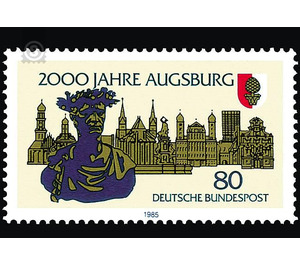2000 years Augsburg - Germany / Federal Republic of Germany 1985 - 80 Pfennig
Theme: Architecture
| Country | Germany / Federal Republic of Germany |
| Issue Date | 1985 |
| Face Value | 80.00 |
| Color | brown white |
| Perforation | K 14 |
| Printing Type | 5-color offset |
| Stamp Type | Postage stamp |
| Item Type | Stamp |
| Chronological Issue Number | 1107 |
| Chronological Chapter | GER-BRD |
| SID | 257319 |
| In 53 Wishlists | |
2,000 years Augsburg The history of Augsburg begins with the occupation of the Alpine foothills by the Romans in 15 BC. From the subsequent colonization of the plateau at the confluence of the Wertach in the Lech, a city developed, which was one of the financial centers of the world after its slow rise in the 16th century, the economic and arts and crafts importance until the end of the 18th century As a Bavarian provincial capital, industrialization in the 19th century provided new opportunities for development. Today it has about 245,000 inhabitants. She is proud of her history, which still shapes the cityscape in numerous architectural monuments. If Augsburg relies on its 2000 years of existence, then it is not about the founding of the city, not even about the beginning of a settlement, even less about a verifiable fixed date, but about the consequent conquest of the area between Iller and Lech by Tiberius and Drusus. This was a bond to the Roman Empire and its culture. The strategically important position at the confluence of Lech and Wertach was soon used by the Romans. They established a legion camp there, whose remains were found in the city of Oberhausen, on the left bank of the Wertach, in 1913. The camp was originally on the terrace slope. His relics can then have come through a change in the river to the site in the lowlands. The very rich remains of weapons, of pieces of metal belonging to the equipment of horses, of human clothing, of equipment and wagons, but also of the coins, lead to the conclusion that the camp was earliest 8 o'clock. It was founded around 16 BC and lasted until about 16 AD. Recent excavations and the investigation of finds from the last decades indicate that the civilian population could have joined the legion camp without a long time interval, that contrary to the previous view, continuity can not be ruled out. Between 25 and 30 n. Chr. Came, as is sufficiently provable, to a planned arrangement of the civil settlement. The expansion of the road to Italy has strengthened Augsburg's importance as a permanent place near the imperial border, and after the middle of the first century it became the residence of the Roman procurator for the province of Raetia. In 98 Tacitus mentioned the splendidissima Raetiae provinciae colonia. But only Ptolemy calls her name for the first time in the middle of the second century: Augusta Vindelica. It had therefore been named after the emperor, under whom the settlement had begun and who had perhaps already decided on their investment. All usual large administration buildings, a forum and a Capitol, are to be proven by excavation remainders, although the later overbuilding and the further use of the stones make a precise reconstruction of the Roman city no longer possible. Unfortunately, no architectural monument has survived even as a ruin. The invasion of the Alemanni in the 8th century had probably already led to a thorough destruction. Even though there are only few testimonies to the Franconian rule in the 8th century, there is evidence of a continuation of the settlement. There are indications that Augsburg was soon to become a center of the church, and it is certain that the cult of St. Afra, a martyr who was killed in 304, continued. Through the administrative form of the Frankish empire, more light then comes back into the history of Augsburg, until it developed from a bishop's town to a imperial city in the Middle Ages. The motif shows a stylized representation of the most important buildings in Augsburg, from left to right: Catholic and Protestant Church of St. Ulrich, Cathedral, Hercules Fountain, Town Hall, Fuggerei, modern hotel tower and arsenal. In the foreground on the left, the bronze bust of the Roman Emperor Augustus and on the top right on a column head, the coat of arms in its present form, the pine cone, a fertility symbol, which had already introduced the Roman soldiers. (Text: Dr. Josef Bellot, Director of the State and City Library Augsburg)


